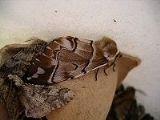
Endromis versicolora
Encyclopedia
The Kentish Glory is a moth
of the family Endromidae
. It is found in the Palaearctic region.
 The wingspan
The wingspan
is 50–70 mm. The moth flies from March to May.
Females, much bigger and paler than males, fly only at night in order to lay eggs. Males can detect female's smell from distance up to 2 km and fly both at night and daylight.
Yellow at first, then purplish-brown eggs are laid in 2–3 "rows" around thin branch of birch. After 10–14 days little black caterpillars hatch.
The caterpillar
s primarily feed on birch
(Betula sp.), but accepts lots of other trees and shrubs: Alnus sp., Corylus sp., Tilia
sp., Carpinus sp. It is green with paler stripes, at first feeds in small groups of 15–30 larvae. Mature ones separate and feed only at night individually.
Endromis versicolora gives only one, spring generation a year; it spend the Winter as chrystalid in thin, loose, but strong cocoon buried at a small depth in the soil.
Moth
A moth is an insect closely related to the butterfly, both being of the order Lepidoptera. Moths form the majority of this order; there are thought to be 150,000 to 250,000 different species of moth , with thousands of species yet to be described...
of the family Endromidae
Endromidae
Endromidae is a family of moths. It was long considered to be a monotypic family, containing just one species, the Kentish Glory, Endromis versicolora, found throughout the Palaearctic region .-Genera:*Andraca*Endromis...
. It is found in the Palaearctic region.

Wingspan
The wingspan of an airplane or a bird, is the distance from one wingtip to the other wingtip. For example, the Boeing 777 has a wingspan of about ; and a Wandering Albatross caught in 1965 had a wingspan of , the official record for a living bird.The term wingspan, more technically extent, is...
is 50–70 mm. The moth flies from March to May.
Females, much bigger and paler than males, fly only at night in order to lay eggs. Males can detect female's smell from distance up to 2 km and fly both at night and daylight.
Yellow at first, then purplish-brown eggs are laid in 2–3 "rows" around thin branch of birch. After 10–14 days little black caterpillars hatch.
The caterpillar
Caterpillar
Caterpillars are the larval form of members of the order Lepidoptera . They are mostly herbivorous in food habit, although some species are insectivorous. Caterpillars are voracious feeders and many of them are considered to be pests in agriculture...
s primarily feed on birch
Birch
Birch is a tree or shrub of the genus Betula , in the family Betulaceae, closely related to the beech/oak family, Fagaceae. The Betula genus contains 30–60 known taxa...
(Betula sp.), but accepts lots of other trees and shrubs: Alnus sp., Corylus sp., Tilia
Tilia
Tilia is a genus of about 30 species of trees native throughout most of the temperate Northern Hemisphere. The greatest species diversity is found in Asia, and the genus also occurs in Europe and eastern North America, but not western North America...
sp., Carpinus sp. It is green with paler stripes, at first feeds in small groups of 15–30 larvae. Mature ones separate and feed only at night individually.
Endromis versicolora gives only one, spring generation a year; it spend the Winter as chrystalid in thin, loose, but strong cocoon buried at a small depth in the soil.

